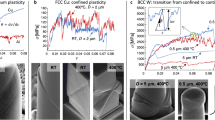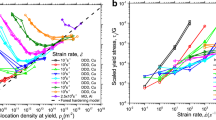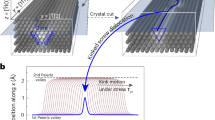Abstract
The distribution of elastic strains (and thus stresses) at the submicrometre length scale within deformed metal single crystals has remarkably broad implications for our understanding of important physical phenomena. These include the evolution of the complex dislocation structures that govern mechanical behaviour within individual grains1,2,3, the transport of dislocations through such structures4,5,6, changes in mechanical properties that occur during reverse loading7,8,9 (for example, sheet-metal forming and fatigue), and the analyses of diffraction line profiles for microstructural studies of these phenomena10,11,12,13,14,15. We present the first direct, spatially resolved measurements of the elastic strains within individual dislocation cells in copper single crystals deformed in tension and compression along 〈001〉 axes. Broad distributions of elastic strains are found, with important implications for theories of dislocation structure evolution3,16,17,18,19,20, dislocation transport4,5,6, and the extraction of dislocation parameters from X-ray line profiles10,11,12,13,14,15,21,22,23,24.
This is a preview of subscription content, access via your institution
Access options
Subscribe to this journal
Receive 12 print issues and online access
$259.00 per year
only $21.58 per issue
Buy this article
- Purchase on Springer Link
- Instant access to full article PDF
Prices may be subject to local taxes which are calculated during checkout


Similar content being viewed by others
References
Kubin, L. in Dislocation Patterning (eds Cahn, R. W., Haasen, P. & Kramer, E. J.) 137–190 (Mughrabi, H. (Vol. ed) Materials Science and Technology, Vol. 6, VCH, Weinheim, 1993).
Sevillano, J. G. in Flow Stress and Work Hardening (eds Cahn, R. W., Haasen, P. & Kramer, E. J.) 19–88 (Mughrabi, H. (Vol. ed.) Materials Science and Technology, Vol. 6, VCH, Weinheim, 1993).
Gómez-García, D., Devincre, B. & Kubin, L. P. Dislocation patterns and the similitude principle: 2.5D mesoscale simulations. Phys. Rev. Lett. 96, 125503 (2006).
Argon, A. S. & Haasen, P. A new mechanism of work hardening in the late stages of large strain plastic flow in f.c.c. and diamond cubic crystals. Acta Metall. Mater. 41, 3289–3306 (1993).
Thomson, R. & Levine, L. E. Theory of strain percolation in metals. Phys. Rev. Lett. 81, 3884–3887 (1998).
Levine, L. E. & Thomson, R. The statistical origin of bulk mechanical properties and slip behavior in fcc metals. Mater. Sci. Eng. A 400–401, 202–205 (2005).
Kassner, M. E., Perez-Prado, M.-T., Vecchio, K. S. & Wall, M. A. Determination of internal stresses in cyclically deformed copper single crystals using convergent-beam electron diffraction and dislocation dipole separation measurements. Acta Mater. 48, 4247–4254 (2000).
Hu, X., Wei, C., Margolin, H. & Nourbakhsh, S. Bauschinger effect and the stresses in a strained single crystal. Scr. Metall. Mater. 27, 865–870 (1992).
Hasegawa, T., Yakou, T. & Kocks, U. F. A unified representation of stress-strain curves in reversed direction of prestrained cell-forming metals. Trans. Japan Inst. Met. 27, 425–433 (1986).
Ungár, T., Mughrabi, H., Rönnpagel, D. & Wilkens, M. X-ray line-broadening study of the dislocation cell structure in deformed [001]-orientated copper single crystals. Acta Metall. 32, 333–342 (1984).
Mughrabi, H., Ungár, T., Kienle, W. & Wilkens, M. Long-range internal stresses and asymmetric X-ray line-broadening in tensile-deformed [001]-oriented copper single crystals. Phil. Mag. A 53, 793–813 (1986).
Ungár, T. & Borbély, A. The effect of dislocation contrast on x-ray line broadening: a new approach to line profile analysis. Appl. Phys. Lett. 69, 3173–3175 (1996).
Ungár, T., Groma, I. & Wilkens, M. Asymmetric X-ray line broadening of plastically deformed crystals. II. Evaluation procedure and application to [001]-Cu crystals. J. Appl. Crystallogr. 22, 26–34 (1989).
Wilkens, M., Herz, K. & Mughrabi, H. An X-ray diffraction study of cyclically and of unidirectionally deformed copper single crystals. Z. Metallkd. 71, 376–384 (1980).
Straub, S. et al. Long-range internal stresses in cell and subgrain structures of copper during deformation at constant stress. Acta Mater. 44, 4337–4350 (1996).
Mughrabi, H. Dislocation wall and cell structures and long-range internal stresses in deformed metal crystals. Acta Metall. 31, 1367–1379 (1983).
Hähner, P., Bay, K. & Zaiser, M. Fractal dislocation patterning during plastic deformation. Phys. Rev. Lett. 81, 2470–2473 (1998).
Zaiser, M. A generalized composite approach to the flow stress and strain hardening of crystals containing heterogeneous dislocation distributions. Mater. Sci. Eng. A 249, 145–151 (1998).
Zaiser, M. & Hähner, P. The flow stress of fractal dislocation arrangements. Mater. Sci. Eng. A 270, 299–307 (1999).
Hähner, P. & Zaiser, M. Dislocation dynamics and work hardening of fractal dislocation cell structures. Mater. Sci. Eng. A 272, 443–454 (1999).
Krivoglaz, M. A. & Ryaboshapka, K. P. Theory of X-ray scattering by crystals containing dislocations, screw and edge dislocations randomly distributed throughout the crystal. Fiz. Metal. Metalloved. 15, 18–31 (1963) Engl. transl: Phys. Metals Metallogr. 15, 14–26 (1963).
Wilkens, M. The determination of density and distribution of dislocations in deformed single crystals from broadened X-ray diffraction profiles. Phys. Status Solidi A 2, 359–370 (1970).
Levine, L. E. & Thomson, R. X-ray scattering by dislocations in crystals. General theory and application to screw dislocations. Acta Crystallogr. A 53, 590–602 (1997).
Groma, I. X-ray line broadening due to an inhomogeneous dislocation distribution. Phys. Rev. B 57, 7535–7542 (1998).
Jakobsen, B. et al. Formation and subdivision of deformation structures during plastic deformation. Science 312, 889–892 (2006).
Ungár, T. Characteristically asymmetric X-ray line broadening, an indication of residual long-range internal stresses. Mater. Sci. Forum 166–169, 23–44 (1994).
Ungár, T., Mughrabi, H., Wilkens, M. & Hilscher, A. Long-range internal stresses and asymmetric X-ray line-broadening in tensile-deformed [001]-oriented copper single crystals: the correction of an erratum. Phil. Mag. A 64, 495–496 (1991).
Borbély, A., Blum, W. & Ungar, T. On the relaxation of the long-range internal stresses of deformed copper upon unloading. Mater. Sci. Eng. A 276, 186–194 (2000).
Larson, B. C., Yang, W., Ice, G. E., Budai, J. D. & Tischler, J. Z. Three-dimensional X-ray structural microscopy with submicrometre resolution. Nature 415, 887–890 (2002).
Yang, W. et al. Spatially resolved Poisson strain and anticlastic curvature measurements in Si under large deflection bending. Appl. Phys. Lett. 82, 3856–3858 (2003).
Yang, W. et al. Differential-aperture X-ray structural microscopy: a submicron-resolution three-dimensional probe of local microstructure and strain. Micron 35, 431–439 (2004).
Ice, G. E. et al. Polychromatic X-ray microdiffraction studies of mesoscale structure and dynamics. J. Synchrotron Radiat. 12, 155–162 (2005).
Ledbetter, H. M. & Naimon, E. R. Elastic properties of metals and alloys. II. Copper. J. Phys. Chem. Ref. Data 3, 897–935 (1974).
Acknowledgements
M.E.K. and M.D.R. acknowledge support from the Office of Basic Energy Sciences (BES), DoE, and thank the National Center for Electron Microscopy at LBNL for access to the TEM. Research at ORNL is supported by DoE BES Division of Materials Sciences under contract with UT-Battelle, LLC. The XOR/UNI facilities on sectors 33 and 34 at the APS are supported by the US DoE, Office of Science.
Author information
Authors and Affiliations
Corresponding author
Ethics declarations
Competing interests
The authors declare no competing financial interests.
Rights and permissions
About this article
Cite this article
Levine, L., Larson, B., Yang, W. et al. X-ray microbeam measurements of individual dislocation cell elastic strains in deformed single-crystal copper. Nature Mater 5, 619–622 (2006). https://doi.org/10.1038/nmat1698
Received:
Accepted:
Published:
Issue Date:
DOI: https://doi.org/10.1038/nmat1698
This article is cited by
-
Understanding the impact of texture on the micromechanical anisotropy of laser powder bed fused Inconel 718
Journal of Materials Science (2022)
-
Basis for the Bauschinger effect in copper single crystals: changes in the long-range internal stress with reverse deformation
Journal of Materials Science (2019)
-
Microstructural Origin of Residual Stress Relief in Aluminum
Metallurgical and Materials Transactions A (2019)
-
Machine learning plastic deformation of crystals
Nature Communications (2018)
-
Deformation twinning and grain partitioning in a hexagonal close-packed magnesium alloy
Nature Communications (2018)



